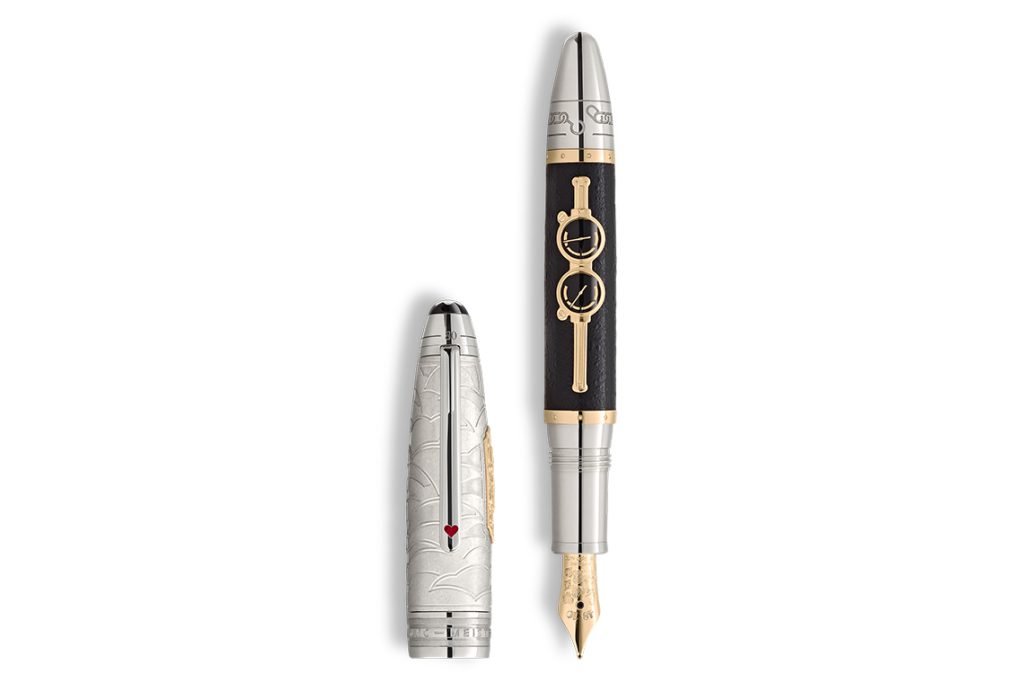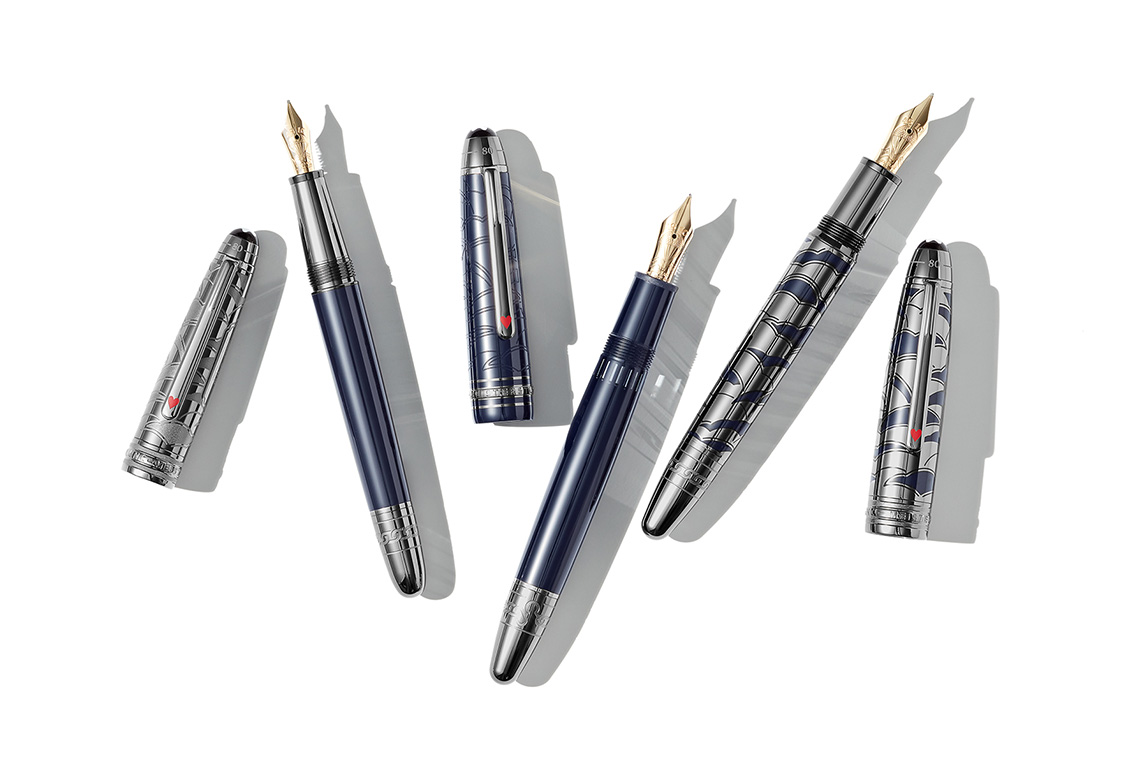Montblanc’s creation of layered objets d’art is rooted in savoir-faire and visionary craftsmanship as much as in the people, stories and art movements that inspired it.
Since 1906, Montblanc has been revolutionising the culture of writing through mechanical invention and aesthetic ingenuity. Founded by German technician August Eberstein and Hamburg-based entrepreneurs Alfred Nehemias and Claus Johannes Voss, their development of non-leaking writing instruments marked the start of a journey where traditional craftsmanship and precision meet modern innovation and artistic liberty.
Montblanc’s refined craftsmanship extends across its production of watches, leather goods, technologies and accessories, yet it is likely most synonymous with the pen. Simple but essential, each writing instrument is an artwork in and of itself, a quality deeply engrained within Montblanc’s approach. Generating an elegant full circle, it pays homage to the people and concepts that have formed the creative landscape throughout time through the release of limited-edition collections such as Signs & Symbols, High Artistry, Writers Edition, Patron of Art and Masters of Art, among others.
Each collectible series demonstrates technical excellence and masterful design to reframe expectations and perceptions of both the object and the inspiration. This is notably embodied in the High Artistry editions, where historical themes and motifs are translated through what Montblanc describes as “the exquisiteness of ancient métiers d’art” at its Artisan Atelier in Hamburg. The Patron of Art pieces, produced annually since 1992, pay tribute to those who have left an indelible mark on the arts, such as Peggy Guggenheim. The Masters of Art pens, meanwhile, acknowledge the importance of artists in documenting and shaping the story of humanity, recently revealing its Pierre-Auguste Renoir instruments. In holistically considering the Montblanc design universe, a guiding ethos quickly appears: storytelling.
In 2022, the MONTBLANC HAUS was inaugurated in Hamburg to reinforce a mission of reconnecting the public with the potential of ‘putting pen to paper’. The written word is a powerful tool, and while supporting the expression of current and future generations through its instruments, educational programmes and initiatives, it does not forget its roots. Montblanc’s meticulous attention to detail, craftsmanship and innovation can be discussed at length, but each of Montblanc’s objets d’art begins with a simple tale.
The Writers Edition pens celebrate what Montblanc sees as one of mankind’s most significant achievements, the written word and literature. It is a form of art that encompasses imagination, invites new discourse, shifts perceptions and cultivates cultural movements as much as traditional modes of artmaking. This collection creates an elegant trifecta of literature, writing instruments, and artistry wherein the writing instrument becomes an expression and expressor of art itself. The latest release to embody this is the Meisterstück Around the World in 80 Days series, the third and final design inspired by French novelist Jules Verne.

Montblanc’s most known piece, the Meisterstück, first introduced in 1924, offers both the opportunity and challenge for artisans to rethink a pen adored by many for generations. This is when a tool becomes more than just an object, transformed by history, context and infusion of artistic intent. The 1871 book Around the World in 80 Days is the story at the heart of these designs, recounting how Phileas Fogg and his valet, Passepartout, embark on an adventure. Translated into form by Montblanc artisans, the first instalment of the Jules Verne collection focused on Fogg’s trip from London to Bombay, the second on the path to Yokohama, and the third covering his return home to London via the United States. Carefully merging artistic liberty with Montblanc’s craftsmanship while maintaining the book’s narrative integrity, details across the entire collection have been included to captivate. A smoke-like pattern with two pressure valve illustrations decorates each pen cap, a nod to the protagonist’s use of locomotives. The cartouche always displays a train, the cone is engraved with rivets and chains (as found between carriages), and the clip features a lacquered red heart, indicative of Fogg’s marriage to an Indian princess he rescued. There are also deeper symbols to be uncovered, for example, handcrafted nibs may reveal a hot air balloon, pointing to Verne’s first adventure novel, Five Weeks in a Balloon (1863).
The four editions comprising of the final instalment, however, have a distinct touch, a testament to Montblanc’s proclivity for fresh artistic interpretation. The Meisterstück Around The World in 80 Days Resin Classique & LeGrand has a polished precious dark blue resin cap and barrel detailed with a milled smoke pattern, lasered train cartouche, and ruthenium-coated fittings. Likewise defined by a precious dark blue resin barrel and lasered train cartouch, the Meisterstück Around The World in 80 Days Doué Classique Edition has a ruthenium-coated smoke and pressure valve-etched cap. The third design, the Meisterstück Around The World in 80 Days Solitaire LeGrand Edition, possesses a ruthenium-coated cap and barrel with a dark blue lacquered smoke pattern and pressure valves, while the side of the cap showcases a lasered train cartouche.
The Meisterstück Around The World in 80 Days Limited Edition 811, however, is notable for its elevated details. Its name references the eight cities and 11 countries Fogg visited. A black lacquer barrel, suggestive of a locomotive’s structure, is framed by two Au 750 solid gold rings and has Au 750 solid gold inlay representing pressure valves. The Ag 925 sterling silver cap continues the series’ etched smoke pattern, while the cartouche hints at his mountainous train journey with Au 750 solid gold set in a frame with rivets. The nib draws upon the wager that sparked the journey – the Au 750/18K gold nib is adorned with all four card suits – and is further enhanced by a 1.5-milimetre black spinel in recognition of the black coal used for trains historically. As a final touch, the pen is crowned with a mother-of-pearl Montblanc emblem set in black onyx.
The collection is rounded out with a stationary set and accessories in an equally sophisticated palette. Blue, evocative of sea and sky, is selected for the map-adorned leather notebook, ink cartridges and ink bottle, while stainless steel cufflinks, tie bar and money clip embody the complementary hot air balloon motif. Translated by Montblanc’s sensitive artistry, each instrument-cum-objet d’art recounts a timeless story and produces a vivid visual universe that allows both enjoyment at a distance or full immersion within the piece.



